Journey of a Torah Scroll
I was at an event at the British Embassy in November 2021 when I was introduced to a Rabbi called David Maxa and he asked me if I knew about the return of a Czech Torah Scroll. It would be a few more weeks before I understood what was a strange, sad and ultimately uplifting story of a sefer Torah scroll, the most sacred hand-written text in Judaism. It had been confiscated by Nazis in WW2, sold by the communists and then travelled thousands of kilometres before returning to a place just a 90 minute drive from where it was originally written.
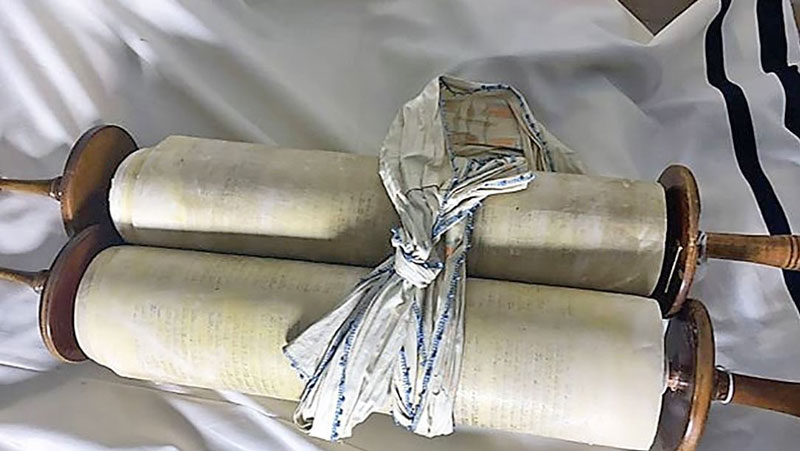
What is a Torah?
A Torah is a written set of ideas, wisdom and guidance for how a Jewish person should live their lives. It contains the Pentateuch or the five books of Moses written in the order Genesis, Exodus, Leviticus, Numbers and Deuteronomy. This constitutes the first five books of Hebrew bible (and the Catholic bible as well). For Jewish rituals a hand-written “Sefer” Torah must be used. A Sefer Torah could be written for a specific synagogue or for a private individual but they are normally kept in a synagogue in something called the Torah Ark. In our case a Sefer Torah was completed in the Czech city of Brno in 1890 and we’ll follow its journey.
Reform or Orthodox?
Not wanting to immerse myself in the religion I take a simplistic view of the differences between the Orthodox and Reform (Progressive) versions of Judaism. Basically Orthodox congregations believe that the Pentateuch is God’s actual words to be literally followed. Reform congregations view the Pentateuch as something to be interpreted for use in modern times.
World War Two and Communism
From late 1941 the Czech Jewish population started to be relocated from their homes to the Terezin and Lodz ghettos and the Nazi regime issued orders that before being closed, all synagogues were required to send their valuables to Prague. By valuables they meant precious metals and ritual decorations which were to be sent to Prague for cataloging and storage by the Jewish Museum. But it’s clear that the Jewish Hierarchy themselves encouraged the transfer of other precious items like the Torah scrolls to prevent things being destroyed by Fascist supporters outside of Prague (several synagogues had already been burned down). This amounted to more than 212,000 items being added to the Jewish Museum collection including @1800 Torah scrolls (it is known that many Torah scrolls were buried for later retrieval but only a fraction were actually reclaimed and it’s thought that many Jewish cemeteries still contain buried scrolls). This collection ended up being spread out over more than 60 different buildings.
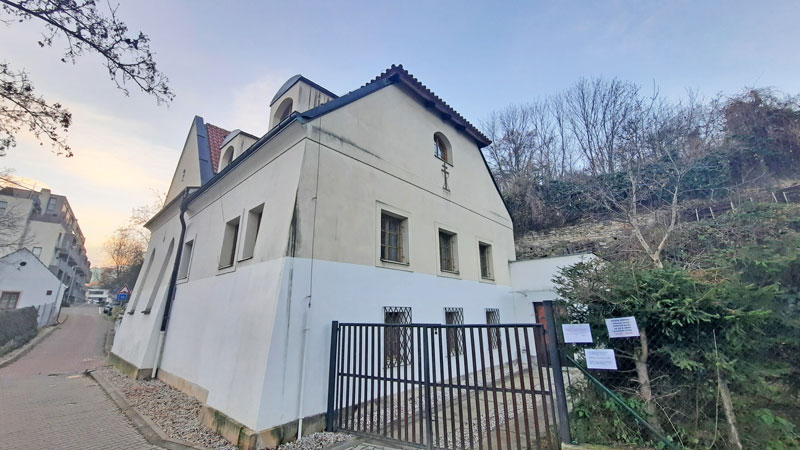
In 1943 the curators of the Jewish Museum, knowing that they were about to be called for transport, arranged for the 1800 Torah scrolls to be moved to various locations in Prague. In 1958 as those locations were being taken over for other uses, many scrolls were taken to the relative safety of an unused synagogue on the outskirts of the city in the town of Michle pictured above. As all but two of the permanent curators died in the Holocaust and the communists took control of Czech in 1948 the contents of the old Michle synagogue were largely forgotten until 1962.
Items For Sale
In the 1960s the communist government needed hard foreign currency and the department that controlled the sale of art and documentation was called Artia. Artia wanted to make money by selling those 1800 scrolls and needed to find somebody with whom they could deal, but who also had Jewish connections. One person who fit the bill was an American art dealer who owned the Grosvenor Gallery in London. Eric Estorick regularly dealt with Artia and was approached in 1963 to see if he would buy the scrolls.
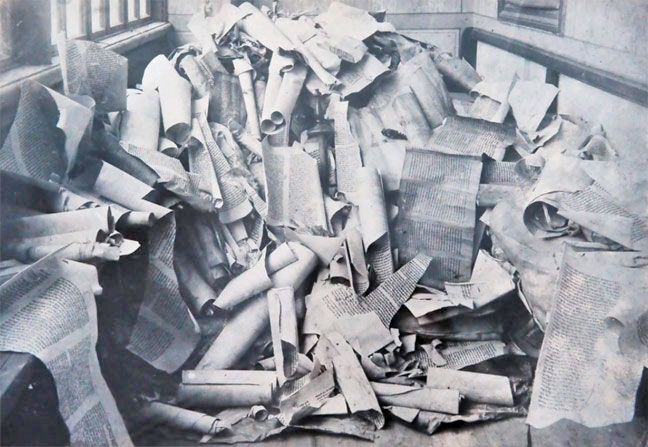
In Mr Estorick’s circle of clients was a solicitor called Ralph Yablon who was involved in financing the Westminster Synagogue (Reform) run by Rabbi Dr. Harold Reinhart. They asked Professor of Hebrew and Jewish Studies, Chimen Abramsky to authenticate the scrolls and based on his assessment the Ralph Yablon bought all of the scrolls that were at the Michle Synagogue which, when properly packed, came to either 1562 or 1564 depending on which records you read.
Of course there were discussions about the ethics of buying something which did not belong to the seller but it was considered “State” property and Chimen Abramsky made it clear that many of the Torah scrolls would be impossible to restore if they waited longer. The asking price was U$30,000 (about U$275,000 in todays money). It later transpired that Israel had been offered the scrolls the previous year but those negotiations had broken down.
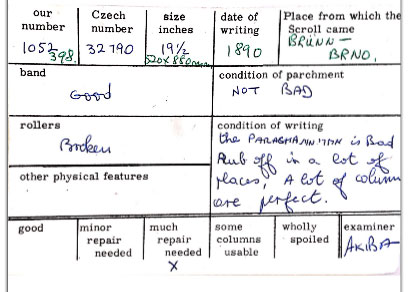
Our Brno Torah scroll was now packed into a box and transported along with others on several lorries the first of which arrived at the Westminster Synagogue on February 7th 1964. It took over a year just to professionally assess the scrolls to see what were “kosher” and could be used for rituals, what could be repaired to be used for rituals and what were “possul” i.e. those which could never be used for rituals. Pictured above is the original assessment from 1964 which shows our scroll #1052 listed as “Not Bad” but overall they ticked the “Much Repair Needed” box. The fact that it was the Reform Westminster Synagogue that now owned the scrolls will become important in our story as you will see.
The Sofer
A Sofer is professionally trained and usually an Orthodox Jewish scribe. They are typically wanderers who move from place to place swapping their writing/restoration skills for room and board. In the summer of 1965 a Sofer by the name of David Eliahu Brand knocked on the door of the Westminster Synagogue and asked, in Yiddish, did they have any Torah scrolls that needed repairing? Having been invited inside I imagine he did not realise that he would be working here for the next 27 years. In all that time he was always referred to as Mr Brand or The Sofer. 1965 was the same year that the Memorial Scrolls Committee was formed to oversee the work.
In a twist of fate, the following year in 1966 the new Chief Rabbi of England was named as Immanuel Jakobovits. His uncle was Dr Tobias Jakobovits, the Jewish Librarian in Prague and one of the curators of the Jewish Museum. He was one of the people who catalogued the incoming items in 1942-44 and was deported after this work was done. He died at the Auschwitz camp.
Memorial Scrolls Trust
Whereas the Memorial Scrolls Committee was created in 1965 to oversee the management and restoration of the scrolls, the Memorial Scrolls Trust or MST was a charity set up in 1980 to separate the Westminster Synagogue activities from anything directed related to the scrolls, including the museum. MST owns all of the 1564 scrolls and administers how they are loaned around the world. You can read about them and the people who were historically involved in this project on the Memorial Scrolls Trust website.
Who Gets What?
If classifying the scrolls was difficult then sending them out into the world became a major problem. Where one expert said that minor repairs were required, another would say extensive repairs were required. One country wanted all the scrolls, another only the Kosher scrolls. Then who would receive them, Orthodox, Reform, new settlements in Israel, Youth groups in the USA? Absolutely anybody could ask for a scroll for various reasons and it was the job of the Memorial Scrolls Committee to decide which requests were valid and which were not.
Our Brno Scroll and the Kutz Camp
Our Sefer Torah was completed in 1890 in the town of Brno, modern day Czech Republic and in today’s money it would have cost in excess of £20,000. The Memorial Scrolls Trust cannot be any more specific about it’s original location i.e. family/synagogue because the Prague records only state “from the Brno Synagogue” which had acted as a central receiving point in the area. In the 1964/65 classification it was listed as “Much Repairs Needed” most likely for individual page damage and faded text. That same year 1965 was when the NFTY (Jewish Reform Youth League) acquired the Kutz Camp in Warwick, NY and used it as a summer camp hosting the Reform Centre for High-level Leadership training for the next 54 years. It was this Reform connection which in 1974, led the Memorial Scrolls Trust to loan them our Brno scroll or what by now was called the Memorial Scrolls Trust Scroll #1052. In 2013 a 23 year old Jewish Studies student called David Maxa attended the Kutz summer camp and read from our Torah.
Our Torah Scroll Returns On Loan
The Kutz Camp continued in it’s teaching role and David Maxa’s Rabbinical studies continued in Israel, Germany and curiously included the Westminster Synagogue in London where he first learned of the Czech provenance of Scroll #1052. On September 10th 2020 David Maxa was confirmed and became the Rabbi of the small Ec Chajim Reform synagogue in Prague (etz hayim or etz chaim is Hebrew for the “Tree of Life” but in Czech is sounds like “ec chajim”).
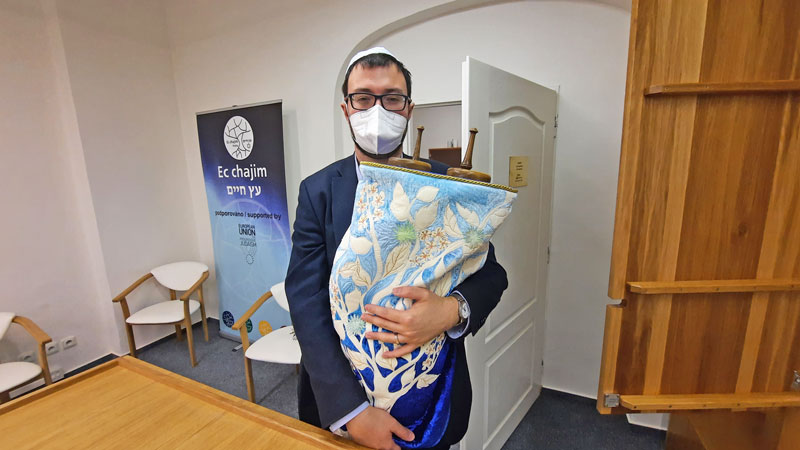
By then it was known that the Kutz Camp was closing and Torah Scroll #1052 was being returned to London so a question of where it would go next was discussed. Even though there are many worthy new synagogues and congregations around the world it was seen as a “coming home” that one of the original Czech scrolls should return to the Czech Republic and David Maxa’s new synagogue. However, there was a major stumbling block. Scroll #1052 was so damaged that it was not considered kosher and could not be used for religious purposes. But the congregation at the Ec Chajim synagogue raised a considerable sum in order to make the necessary repairs.
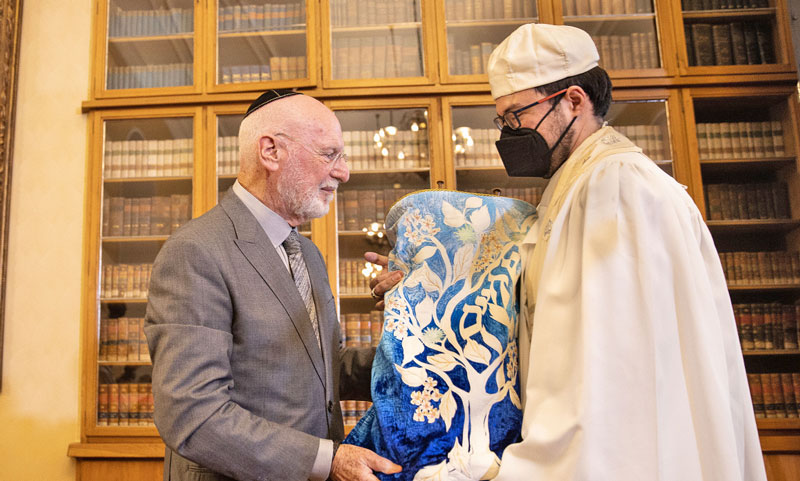
Torah scroll #1052 was formally loaned to the Ec Chajim synagogue on September 27th 2021 where it now sits a little under 200km from where it was originally written. Ritual reading began on the same day i.e. the festival of Simchat Torah where the scroll is rewound back to the beginning of the first book, Genesis: verse 1. I was fortunate to be able to meet Jeffrey Ohrenstein on a trip to London in March 2022 when he and a colleague kindly showed me around their museum and answered my many questions.
The Mantle
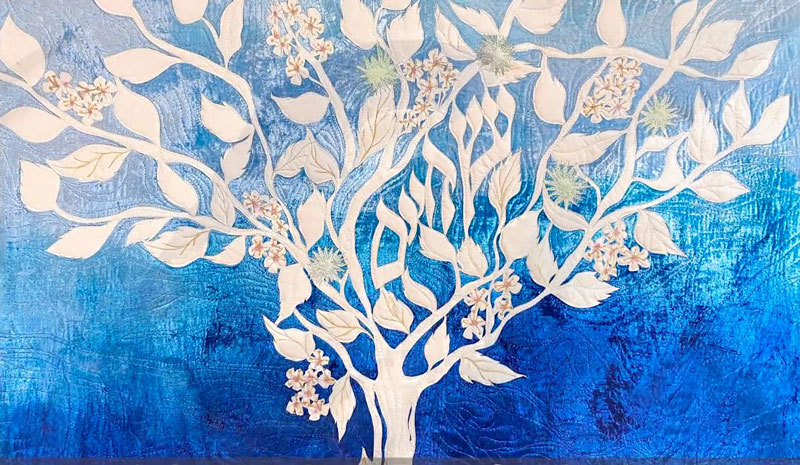
For some reason all of the rescued 1564 scrolls had been separated from their covers or what are called Mantles. So a new one had to be created for MST Scroll #1052. For this they commissioned an American lady called Jeanette Kuvin Oren and to draw it even closer to Czech, her family are descended from the famous Prague Rabbi Loew. A video on her website called “Making a Torah Cover for Prague” captures the process for the creation of the mantle for MST Scroll #1052.
Resources
If you want to find out more detail about the scrolls then in England pay a visit to the Memorial Scrolls Trust Museum or check my review of a book called Out of the Midst of the Fire written by Philippa Bernard, one of the MST trustees.
Something Related or a Few Minutes Away
The Destruction of the Jewish Ghetto
The Rebuilding of the Jewish Quarter
Book Review – Prague’s Stolpersteine Defiant in Their Memory
Attraction – Old Jewish Ceremonial Hall
Attraction – Spanish Synagogue
Attraction – Jubilee Synagogue
